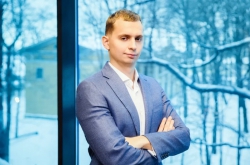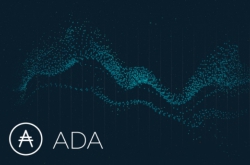How Aira project came to be?
Having graduated from ITMO University and worked at the EPAM Systems company, Sergei Lonshakov founded his own web development studio, and then asked himself whether he could advance any further. He first learned of blockchain in 2012 - one of his acquaintances told him of some "magic" program that brought money to a bitcoin wallet's balance and allowed to quickly transfer it to a cellphone's balance or a Webmoney wallet providing one had a powerful graphics card. Sergei understood that this was a service for bitcoin mining.
After studying the Investments section of the State of Bitcoin Report (a trimestrial report of the CoinDesk analytical service) and analyzing the statistics, his team understood that the future belongs to the development of opportunities presented by blockchain technology. They've decided to focus on the Ethereum platform and its idea of smart contracts. The term isn't new - it was proposed by Nick Szabo, computer scientist, legal scholar and cryptographer back in 1994; later, the concept was brought to life by VitalikButerin, Ethereum's co-founder. Such contracts allow exchanging money, property, stocks or any assets without having to use agents. The contracts are written as code, saved and backed up in the system, and are executed by a network of computers that manage the blockchain.
In fact, Sergei Lonshakov had quite a vague understanding of Ethereum and smart contracts at that time – the team had to experiment a lot, and spent half a year writing their first code.
After getting the gist of Etherium, Airalab's team got the idea to use smart contract not for deals between humans only, but also in direct economic interactions between humans and robots.
Robot economy: basic principles
The idea was finalized as the Robot Economics Doctrine which describes the basic principles of a future system of human-robot interaction. One of them is that the system has to be decentralized: there should be no common center, and the interaction is to be based on direct liability contracts of autonomous robots. This will allow to avoid many risks - for instance, a single failure will not affect the system as a whole.
Also, the new robot economy has to be safe for humans and independent from their economy - this is why robots won't have any proprietary rights and will interact with other network's participants based on contract liabilities. The robot economy is to have its domestic capital; yet, its existence is only possible as part of the digital economy concept.
How new markets are created as part of robot economy?
First of all, for creating a new market as part of the robot economy there must be the idea market.

“It all begins with a visionary who will create the market for the idea. Then, investors come and assess whether the idea is promising or not, and buy some of the market's futures, thus injecting money into the market. Then, industrial partners, i.e. manufacturers (plants that use robots) make a decision of whether to launch the production of a product based on the market's volume and costs of refitting of the production," shares Alexander Kapitonov.
How will it work?
One of the projects that are based on Aira's (Autonomous Intelligent Robot Agent) technological solutions is Drone Employee - a project on controlling a drone fleet. It is based on Ethereum and smart contracts, as well. According to Alexander Kapitonov, if there's a delivery service that makes use of drones only, the Drone Employee can act as an industrial partner that provides a particular service on the market.
Another example: a visionary comes to the market and proposes to create boilers that have a data transfer function. The idea is assessed by investors, and then, having analyzed the estimates for the futures, a boiler production plant makes a decision: whether to refit the production or not. If the industrial partner understands that refitting would be profitable, he begins the production, explains Alexander.
Another opportunity presented by the robot economy will be beneficial not just for the companies, but common users as well, as with Aira, they will have a fast and direct access to services with no need for contractors.
 Sergei Lonshakov and Alexander Kapitonov
Sergei Lonshakov and Alexander Kapitonov
"Owning something might become ineffective in the future. Renting and getting services is much more efficient. Why the car sharing concept came to be? That's because people now need not the car itself but mainly the service - to get to a particular place, says Alexander Kapitonov. The Aira project implies renting robots or any other kind of device by using internal currency and thus getting the service."
How is it done from the technical point of view? To start working, you need to download Aira's image on your computer and specify the cost the service is to be sold at. Then, the robot will post the offer, and Airalab's team will allow the customer to connect to the market and choose the offers he's interested in.
"When a person buys particular data, the robot will know that the contract has been paid, perform the task and report it. We use an IPFS-network for that: upon completing its task, the robot adds the results to IPFS, and the hash of an IPFS-file is unchangeable. Then, only after the hash of the completed task is published, the money - air tokens - will go to the beneficiary," explains Sergei Lonshakov.
What is the project's current stage?
In the end of May, Airalab's team got $220,000 of investments from Cybernator, a pre-seed fund of Satoshi Fund company. Cybernator purchased 165,000 air tokens for 1100 EHT (ether - Ethereum's currency). On May 25, Airlab's team began the first phase of ICO (initial distribution of the system’s tokens) so as to distribute 1 million tokens (those will be used to pay for the autonomous robots' services).
ICO's first phase ended on May 28 - during the course of just three days, 95 investors invested 5,000 ethers into the project (that would be $820,000 according to ether's rate from May 28 or $1,950,000 according to ether's rate from June 13). If the experiment of creating a decentralized robot system will succeed, air tokens will become its most important part - not only will they allow to launch smart contracts, but also contribute to the creation of the new economy's capital as well.
What is the project's future?
The developers plan to use the profits for launching an MVP project. Alexander Kapitonov stresses that now his team works on developing the elements of robot economy's basic infrastructure.
"In our case, the MVP will be like this: in the nearest future, we will start developing services that will exist in ether and interact with it. That would include solutions for infrastructure which will allow to create markets of particular products for the robot economy, solutions for gathering data for Aira's learning and cognitive services, analytical services for the robot economy, services for analyzing the equipment of a plant –a potential industrial partner who is up to refit and wants to assess the refitting costs, and services for its rearrangement," comments Alexander Kapitonov.
Aira's team is planning to complete the MVP before 2017-2018's winter, when the second phase of ICO will begin. What is more, Airalab has already begunto attract international partners to its project and is expanding the project’s community. All the changes to the project are published on Aira's website.






